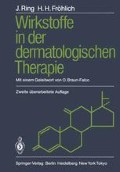Zusammenfassung
Juckreiz ist ähnlich wie Schmerz eine nociceptive Empfindung, die sich jedoch nur an der Haut und den angrenzenden Schleimhäuten auslösen läßt. Obwohl Juckreiz eines der prominentesten Symptome von Hauterkrankungen darstellt, sind die Mechanismen des Pruritus noch keineswegs aufgeklärt. Man ist sich weitgehend einig, daß es keine Juckreiz-spezifischen Nervenendigungen gibt,daß vielmehr verschiedenste sensible Rezeptoren der Haut Juckreiz vermitteln können [1, 2].
Access this chapter
Tax calculation will be finalised at checkout
Purchases are for personal use only
Preview
Unable to display preview. Download preview PDF.
Literatur
Shelley WB, Arthur RR (1957) Neurohistology and neurophysiology of the itch sensation in man. Arch Dermatol Syph 76: 296–323
Stüttgen G (1983) Pruritus: Pathophysiologic und therapeutische Konsequenzen. Fortschr Prakt Dermatol Venerol 10: 1–12
Stüttgen G, Schäfer H (1974) Funktionelle Dermatologie, Springer, Berlin Heidelberg New York
Hägermark 0, Strandberg K (1977) Pruritogenic activity of prostaglandin E2. Acta Derm Venereol 57: 37–43
Greaves MW, McDonald-Gibbson W (1973) Itch: Role of prostaglandins. Br Med J 3: 608–609
Summerfield JA (1981) Pain, itch and endorphins. Br J Dermatol 105: 705–712
Bernstein JE, Swift RM, Soltani A, Lorencz AL (1982) Antipruritic effect of an opiate antagonist naloxone hydrochloride. J Invest Dermatol 78: 81–83
Wünecke P, Bosse A (1981) Kratzen. Münch Med Wochenschr 123: 992–998
Rosen T (1974) Uremic pruritus: a review. Cutis 23: 790–792
Braun-Falco O, Ring J (in press) Zur Therapie des atopischen Ekzems. Hautarzt
Meyer BJ, Nolte A (Hrsg) (1977) Die Pharmakologie, Toxikologie und klinische Anwendung langwirkender Lokalanaesthetika. Thieme, Stuttgart
lla.Tabia L (1977) Pruritus in dialysis patients treated with parenteral lidocaine. N Engl J Med 296: 621–265
Aulepp H (1983) Juckreiz - ein Symptom und seine Therapie. In: Offizinpharmazie, B6. Georg Thieme, Stuttgart New York, S 1–13
Gloor M (1982) Pharmakologie dermatologischer Externa. Springer, Berlin Heidelberg New York
Ring J, Ahlborn R (1983) Allergische Erkrankungen: Pathophysiologic, Hyposensibilisierung, Arzneimitteltherapie. Deutscher Apothekerverlag, Stuttgart
Petersen JA (1980) Relief of generalized pruritus in dialysis patients treated with activated oral charcoal. Ann Intern Med 93: 446–448
Gilchrest TA (1979) Ultraviolet phototherapy of uremic pruritus. Ann Intern Med 91: 17–21
Baum J (1982) Die Akupunktur der Schmerzbehandlung. Dtsch Med Wochenschr 107: 348
Carlsson CA, Augustinsson LE, Lund S, Roupe G (1975) Electrical transcutaneous nerve stimulation for relief of itch. Experientia 31: 191
Author information
Authors and Affiliations
Rights and permissions
Copyright information
© 1985 Springer-Verlag Berlin Heidelberg
About this chapter
Cite this chapter
Ring, J., Fröhlich, H.H. (1985). Antipruritinosa. In: Wirkstoffe in der dermatologischen Therapie. Springer, Berlin, Heidelberg. https://doi.org/10.1007/978-3-642-70025-5_12
Download citation
DOI: https://doi.org/10.1007/978-3-642-70025-5_12
Publisher Name: Springer, Berlin, Heidelberg
Print ISBN: 978-3-540-13769-6
Online ISBN: 978-3-642-70025-5
eBook Packages: Springer Book Archive

